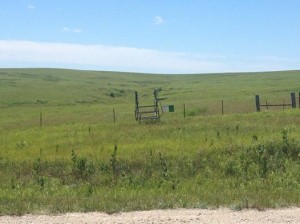Prairie Rattlesnake
Prairie Rattlesnake. Photo by Shaina Niehans
The PRAIRIE RATTLESNAKE (Crotalus viridis) is 3-4 feet long. It is especially common in western Kansas in open rocky areas, prairies and even agricultural land. The prairie rattler eats mostly small rodents such as white-footed mice, shrews, voles, house mice plus prairie dogs, small birds & young rabbits. Its fangs deliver an hemotoxic venom that circulates through the bloodstream causing tissue damage and internal bleeding plus very intense pain. It is active in the daytime. It has an infrared (heat) sensing pit located between the eye and nostrils. This feature is shared by cottonmouths and copperheads collectively referred to as pit vipers, although cottonmouths and copperheads lack a rattle. After being bitten, it is important to get immediate attention at a hospital where anti-venom can be administered. An excellent source of information is The Kansas School Naturalist http://www.emporia.edu/ksn/v05n3-feb1959/index.html. Also a booklet entitled “The Snakes, Lizards, Turtles, and Amphibians of Fort Riley and Vicinity” by Busby, Collins & Suleiman is available from the Kansas Biological Survey in cooperation with the U. S. Department of the Army. It includes photos by Suzanne L. Collins of the Center for North American Herpetology.



